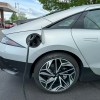
1 Ford F-150 Lightning Surpasses EV Longevity Expectations
Electric vehicles might predate the internal combustion engine, but we’ve never learned about the longevity of EVs. Today’s drivers travel more miles than ever, with some vehicles used for tens of thousands of miles every month. This gives us the perfect opportunity to gain experience about the longevity of the Ford F-150 Lightning.
What do we mean by EV longevity?
The battery pack is the most important and expensive item in any electric vehicle. This item supplies the electrons to the motors to provide power for the drive. It’s well established that EV batteries will lose some charging capability over time. This loss of capacity is also known as battery health.
One Ford F-150 Lightning driver provides reassuring statistics that might help convert other drives to EVs. This driver has spent nearly 93,000 miles behind the wheel of his F-150 Lightning and still reports up to 97 percent of the battery health remaining. This is good news for anyone looking to make their EV a long-term driving solution.
Do combustion engines lose efficiency over time?
If you think that driving range losses are unique to electric vehicles, you’d be wrong. Over time, engine degradation leads to efficiency losses. This means the efficient compact car from five years ago isn’t getting the same mileage as it did when new.

Where has the long-range Ford F-150 Lightning traveled?
The owner of the electric truck, who is proving its worth, has taken this truck on several road trips, climbed mountains, been down at sea level, and used a wide variety of charging stations to add juice to this EV. This means using DC fast chargers when on the road and a home charger when near home.
Good planning makes for excellent battery health
This Ford F-150 Lightning proves charging is importnat to EV longevity. The owner avoids charging to 100% when at home. The truck’s battery never drops below 10% of its charger. These are both suggested uses by most EV manufacturers, but, like regular maintenance, when ignored, can negatively impact battery health.
This same owner reports saving money by using selective free charging whenever it’s available. After 93,000 miles, the battery health reads 97%, and the truck can still charge to 99% of its original capacity. This is good news for this driver.
A good test, but not typical results
Although one driver reports excellent EV longevity and battery health, his experience isn’t typical. In fact, Ford’s warranty covers the battery, retaining at least 70% of its original capacity from the start to the 100,000-mile mark.
The widespread use of electric vehicles is still fairly new. As they become more common, we should learn more about expected battery health, EV longevity, and how automakers can improve these qualities in our future vehicles.
Source: CarScoops






